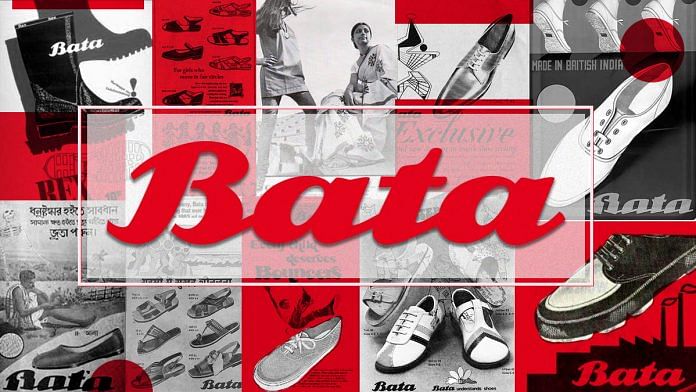New Delhi: In Mira Nair’s Netflix series A Suitable Boy, adapted from Vikram Seth’s magnum opus, protagonist Lata — played by the enchanting Tanya Maniktala — chooses shoemaker Haresh Khanna, played by Namit Das, out of her three potential suitors.
Khanna is an unpopular choice among viewers but Lata’s decision is a layered ode by the book’s author to his father, Prem Seth, who was an executive at Bata.
A foreign shoe brand, Bata is still seen by many Indians as homegrown.
The company took birth in the Czech Republic in 1894 and entered the Indian market in 1931, in Kolkata. At a time when retail stores were not a concept in India, Bata dominated the scene with a branding primarily “limited to word-of-mouth and merchandising through point of sale”, a former Bata executive recalled.
Bata footwear became so popular that a neighbourhood in Kolkata came to be known as Batanagar. The company also designed products meant especially for the Indian market. “Bata products were meant for Indian feet and conditions,” brand strategist Harish Bijoor told ThePrint.
Also read: ‘Modi vest’ is the better known ‘Nehru jacket’, but the go-to formal wear predates both PMs
Bata advertisements as ‘case studies’
Bata, however, faced stiff competition from local brands such as Gola Shoes, Liberty, Paragon and Khadim during the 1980s. This was when Bata went on an advertising spree — showing its undefeated points about utility, durability and pricing.
Bijoor, however, said advertising didn’t do as much for Bata as retail stores. “Universality of the brand in the lives of ordinary people was more important than ubiquity in newspapers or the TV,” he added.
That being said, Bata’s advertisement strategies have long been touted as remarkable “case studies in many MBA schools“. While various advertisements were customised for target audiences, such as men, women, children and the youth, Bata continued to give prime importance to utility and pricing of its footwear.
Its vintage print advertisements were bereft of any catchy one-liners. The brand stuck to a simple, straightforward message about its pricing and durability. For example, an advertisement for sandals read, “Garmi main sukhad sheetalta (pleasing coolness in summer)”, with six different designs of the footwear.
Another ad promoted its designs saying, “step out in style”, while one for its collection of coloured canvas shoes read “sneak into the world of colour”, with an image of young people sporting the footwear.
Also read: Before Maruti 800, there was the quirky Sipani Dolphin, a hit in motorsport circuits
‘An experience’
Those growing up in the 1970s, 80s and 90s have fond memories of Bata school shoes. It used to inevitably be the first pair of school shoes for nearly every boy or girl at the time.
Bata had also developed advertisements that promoted this experience and ritual of a visit to the store before every school session. “First to Bata, then to school” was one of its famous taglines.
“I looked forward to it myself. Entering a Bata store, with its bright lights and trademark red and white logo, people bringing out the foot measures and placing them in front of you, someone fitting the shoes, and boxes upon boxes being opened for you. Bata was a product that cascaded into an experience, which then became daily usage,” Bijoor said.
That was not all. The company is also believed to have introduced many in the Indian subcontinent to the advantages of wearing quality shoes. “Beware of Tetanus, even a small injury could be dangerous — so wear a shoe”, a 1938 tagline for its rubber shoes read.
Many also spoke about how that the brand’s 99.99 paise price tag, which came to be known as the Bata rate, became attractive for customers since it indicated “a low or fair price”.
The price tag enticed the middle class and the brand’s exquisite designs attracted the rich. Delhi-NCR resident and Bata customer Jyoti Bahl said, “Bata played on the psychology of consumers with its 99 paisa strategy.”
Bata’s “small name” also worked in its favour. “The brand name was also completely apt for India. With just four letters and two syllables, it was easy to pronounce for the Indian market,” Bijoor noted, emphasising how this helped the company shed its “international image”.
Also read: Appu Ghar, India’s first amusement park, was all about the thrill of something new




Gola shoes were not a local brand! It’s a British company–though their sneakers were available in India in the 1970s.
Bata to me is the best especially for school kids.i grow up wearing naughty boyd shoes from bata,bata slippers,bata sandals and canvas white color.These days we get plenty of new designs and varieties of styles.
Customer service nice. But product quality very poor
I still recall, one slogan among my friends in early 70s and was and still popular that..” chamar mey Bata aur luhar mey Tata..”
Waiting for my ordered product since 2 months after being paid worst service from bata please don’t pay by relying on online official website and app …
An informative article about BATA , just a small correction if it can be done it’s not 1984 its 1884. I am sorry if I have offended any body . It will help for making any such mistakes in future. 🙂
Bata people are literally thieves. Whole of the manegement from top to bottom are liers and scoundrels. They don’t care about customers at all. I really have a very bad customer experience from them and still regret why I even stepped in their showroom.
Bata is only a brand. They don’t have any manufacturing units, they source 3rd class rexine shoes and sandals and sell it at Rs 2999 bata price tag. Thier leather shoes colour gets fade after 2 weeks of wearing. And they have been fooling around indians for a century now. Congrats Bata.